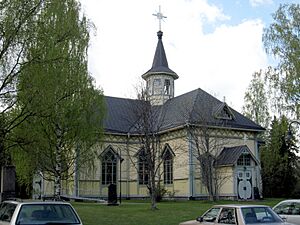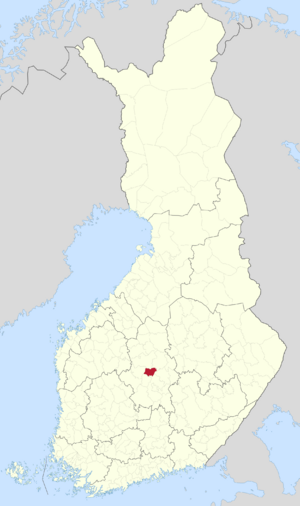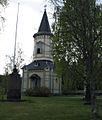Uurainen facts for kids
Quick facts for kids
Uurainen
|
||
|---|---|---|
|
Municipality
|
||
| Uuraisten kunta Uurainens kommun |
||

Uurainen Church
|
||
|
||

Location of Uurainen in Finland
|
||
| Country | ||
| Region | Central Finland | |
| Sub-region | Jyväskylä sub-region | |
| Charter | 1868 | |
| Area
(2018-01-01)
|
||
| • Total | 372.26 km2 (143.73 sq mi) | |
| • Land | 347.98 km2 (134.36 sq mi) | |
| • Water | 24.22 km2 (9.35 sq mi) | |
| Area rank | 221st largest in Finland | |
| Population
(2023-12-31)
|
||
| • Total | 3,615 | |
| • Rank | 201st largest in Finland | |
| • Density | 10.39/km2 (26.9/sq mi) | |
| Population by native language | ||
| • Finnish | 98.3% (official) | |
| • Swedish | 0.1% | |
| • Others | 1.6% | |
| Population by age | ||
| • 0 to 14 | 25.3% | |
| • 15 to 64 | 54.5% | |
| • 65 or older | 20.2% | |
| Time zone | UTC+02:00 (EET) | |
| • Summer (DST) | UTC+03:00 (EEST) | |
Uurainen is a small town, also called a municipality, in Finland. It is located in the Central Finland region.
Uurainen has a population of about 3,615 people. It covers an area of 372.26 square kilometres (143.73 sq mi). About 6.5% of this area is water, mostly lakes. This means there are about 10.39 inhabitants per square kilometre (26.9/sq mi) people living in each square kilometer.
The towns next to Uurainen are Jyväskylä, Laukaa, Multia, Petäjävesi, Saarijärvi, and Äänekoski. In Uurainen, people mainly speak Finnish.
Contents
What's in a Name?
The name Uurainen comes from two lakes: Iso-Uurainen and Pieni-Uurainen. The word uuro is a local dialect word. It means "riverbed." This likely refers to the Takapuro river, which flows between the two lakes. Long ago, this river might have been a narrow channel or strait. Uurainen is also the name of an old village in the area.
Nature and Places
Lakes in Uurainen
Uurainen is a place with lots of water! There are 125 lakes in total. The largest lakes are Kyynämöinen, Sääkspää, and Iso-Uurainen.
Villages and Settlements
Here are some of the places where people live in Uurainen:
- Kotaperä
- Linnanperä
- Pohjanperä
- Kelloperä
- Haukimäki
- Kyynämöinen
- Hepomäki
- Höytiä
- Tehlo
- Kirkonkylä
- Hiirola
- Jokihaara
- Vihtaperä
- Oikarinperä
- Murtoperä
- Kummunkylä
- Pirttiperä
- Myllyperä
- Kangashäkki
- Sälliperä
- Hirvaskylä
Some of the older, official villages are:
- Kuukkajärvi
- Uurainen
- Kangashäkki
- Höytiä
- Nyrölä (most of this village is in Jyväskylä)
A Look Back in Time
Early Settlements
People lived in the Uurainen area a very long time ago. Scientists have found six places where people might have lived during the Stone Age. Four of these spots are in Kuukkajärvi. One is in the village of Uurainen, and another is in Höytiä. There is no clear proof that people lived here permanently during the Iron Age.
First Settlers
During the Middle Ages, no one lived in Uurainen all the time. In the 1400s and early 1500s, people from Tavastia used these lands for hunting. The first person to settle in Uurainen was Paavo Minkkinen. In 1548, he started a farm called Salmela. This farm was in the hunting grounds of Heinäjoensuu. These lands belonged to people from the village of Laitikkala. This area later became the village of Kuukkajärvi.
Paavo Minkkinen and most of the early settlers in Uurainen were Savonian. The Minkkinen family likely came from a place called Pellosniemi, near the city of Mikkeli.
The first official villages in the area were Kuukkajärvi and Akonjärvi. Both were first mentioned in the year 1561. Akonjärvi later joined with Kuukkajärvi in 1586.
Becoming Its Own Parish
Uurainen was originally part of the church area of Saarijärvi. In 1741, it was mentioned by its Swedish name, Uhrais. The area got its own small church in 1801. It was called by different names like Uurainen, Kuukkajärvi, Kuukka, and Minkkilä. It had many names because the main church office (vicarage) was in the village of Uurainen. But the church building itself was in the village of Kuukkajärvi, on the land of the Minkkilä farm.
Uurainen officially became its own church parish in 1868. However, it really started working as a separate parish in 1887. The northern part of Nyrölä, which included Höytiä at that time, joined Uurainen from the Jyväskylä parish in 1868.
Images for kids
See also
 In Spanish: Uurainen para niños
In Spanish: Uurainen para niños




